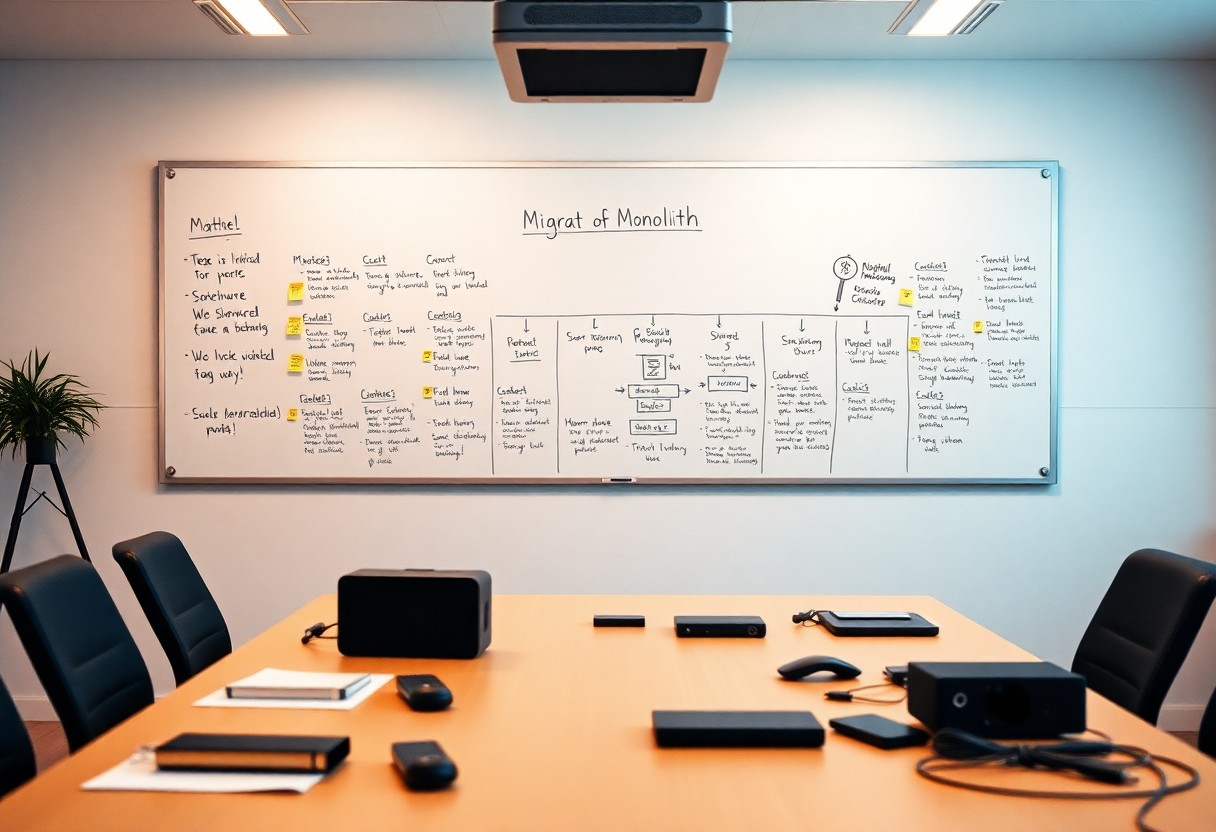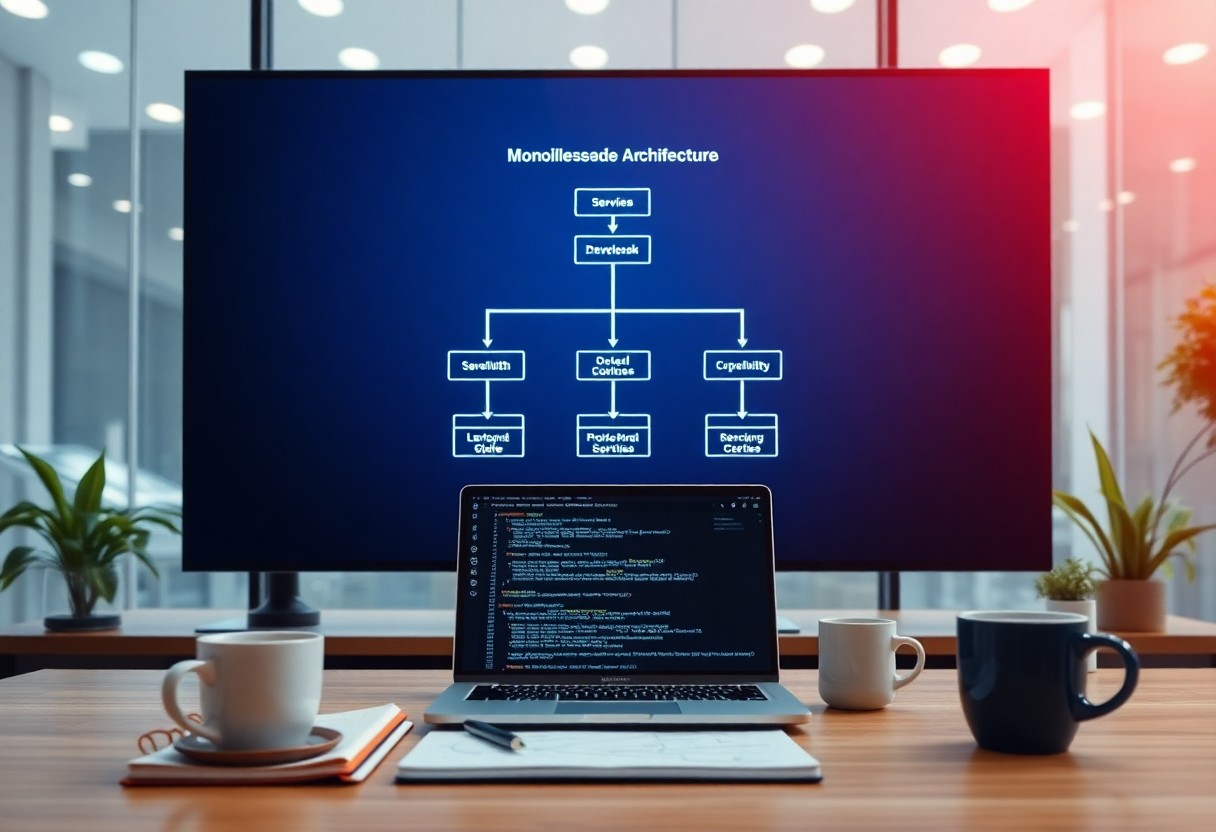This guide will equip you with the crucial knowledge and steps to successfully transition your monolithic application to a serverless architecture. You will learn key concepts, tools, and best practices that simplify this complex migration. By approaching your migration with a clear plan and understanding the serverless landscape, you can enhance scalability, reduce costs, and improve overall performance for your applications. Let’s probe the practical steps that will help you achieve a seamless transformation.
Just envision the efficiency of a serverless architecture, where you can reduce operational burdens and scale effortlessly. This practical guide offers you a step-by-step approach to migrating your monolithic application to a more agile serverless environment. You’ll discover strategies for breaking down your application, optimizing costs, and leveraging cloud services, all aimed at enhancing your development workflow. With the right techniques, transitioning can be smoother than you expect, allowing you to focus on building and innovating without the limitations of traditional infrastructure.
Decoding Your Existing Monolith’s Structure
Understanding your monolith’s architecture is vital before initiating migration to a serverless setup. Examine the underlying components, workflows, and data flows to identify how they are interlinked. This analysis allows you to uncover the complexity of your application, which is key to an effective transition. Focusing on this structure will unveil areas for decoupling and re-architecting to fit a serverless model.
Identifying Core Functionalities
Core functionalities represent the important services that your monolith delivers. Start by mapping business requirements to specific application features. Prioritize these functionalities based on usage frequency and business impact, allowing you to streamline your migration by addressing the most critical components first. This foundational understanding enhances your serverless architecture design.
Assessing Dependencies and Interactions
Your monolith likely has numerous dependencies, both internal and external, affecting how services communicate. Catalog these dependencies to understand their significance and discover potential bottlenecks. This clarity aids in deciding how to unpack these components during migration, ensuring that interactions are smooth and efficient.
During this assessment, investigate into the communication patterns between services, databases, and external APIs. Identify which dependencies are tightly coupled and which can transition independently to serverless functions. For example, if a payment processing function interacts heavily with user management, consider whether these can be separated without disrupting operations. By breaking down layers of interaction, you can establish a clearer migration path, reducing the risks associated with dependency failures in a distributed environment. Tools like dependency graph visualizers can also aid in this exploration, providing maps that showcase how elements of your monolith connect. This information becomes vital as you plan for a gradual, measured decomposition of your application.

The Case for Going Serverless: Cost Efficiency and Scalability
Transitioning to a serverless architecture offers significant cost savings and scalability advantages over traditional models. By only paying for the compute resources you actively use, you eliminate the costs associated with idle server time. Furthermore, serverless platforms automatically scale with your application’s demand, allowing you to focus on development rather than infrastructure management.
Breaking Down Cost Structures: When Serverless Beats Traditional Models
Serverless computing often results in lower operational costs, especially for applications with variable workloads. In a traditional model, you might over-provision resources to handle peak loads, leading to wasted expenses during off-peak periods. With a serverless architecture, you incur costs only for the compute time used, which can significantly enhance your budget efficiency.
The Infinite Scalability Promise: How Serverless Adapts to Demand
Serverless architecture effortlessly manages sudden traffic spikes without the need for manual scaling. As your application experiences fluctuations in user demand, serverless solutions automatically allocate resources, ensuring reliable performance without downtime or over-provisioning. This scalability framework allows you to accommodate thousands of concurrent users instantly.
This infinite scalability is exemplified by platforms like AWS Lambda, which can handle thousands of requests per second by spinning up functions on-demand. For instance, during high-traffic events, online retailers leveraging serverless could prevent slowdowns or outages, ensuring a seamless shopping experience. This flexibility enables your application to grow alongside your business needs, providing a robust foundation for future-expanding capabilities without the burden of infrastructure maintenance. By embracing serverless, you position your application to meet present and future demands.
Crafting a Migration Strategy That Works
A well-defined migration strategy is vital to ensure a smooth transition from a monolithic structure to a serverless architecture. Your approach should encompass assessing your current system, setting achievable goals, and employing the right tools to facilitate the process. Emphasizing a phased migration allows you to validate each step while minimizing disruptions to current operations, empowering your team to efficiently adapt and innovate during the transition.
Setting Clear Objectives and Metrics
Establishing clear objectives and measurable metrics allows you to track progress and evaluate the success of your migration. Identify specific goals such as improved load times, reduced operational costs, or enhanced scalability. Set KPIs like response time, error rates, and user engagement metrics that align with your business objectives, ensuring that you can make data-driven decisions throughout the process.
Choosing the Right Serverless Framework
Your choice of serverless framework can significantly impact the efficiency of your migration. Select one that aligns with your application’s needs, developer experience, and supports the languages and tools your team is familiar with. Popular options such as AWS Lambda, Google Cloud Functions, and Azure Functions each offer unique advantages, like integrated monitoring, scaling capabilities, and extensive community support, so weighing the pros and cons based on your specific requirements will guide you to the right fit.
AWS Lambda, for instance, offers seamless integration with other AWS services, making it an excellent choice if your architecture heavily utilizes Amazon’s ecosystem. In contrast, Google Cloud Functions may appeal more to teams leveraging existing Google Cloud resources. Factors such as cold start performance, pricing models, and deployment tools should also steer your decision. Migrating with a compatible framework minimizes friction and accelerates the serverless benefits your organization can achieve.
Unpacking Your Monolith: Identifying Key Components for Migration
Before exploring into migration, dissect your monolith to recognize its core components. This process involves analyzing your application’s structure, pinpointing distinct services, and determining their interconnections. Look for areas of high complexity or frequent usage that could benefit most from serverless optimization. By understanding the function of each part, a clear roadmap for effective migration emerges, allowing you to transition without losing functionality or disrupting user experience.
Mapping Dependencies: Unraveling the Ties that Bind
You’ll need to identify dependencies between components to understand how they interact and affect each other. Creating a dependency map helps visualize these connections, allowing you to spot tightly coupled services that may require additional attention during migration. This step ensures you mitigate risks associated with breaking critical workflows, thereby enhancing your overall migration strategy.
Prioritizing Services: Which Parts to Convert First
Determining which services to migrate first can significantly streamline your transition. Focus on critical functionalities that improve customer experience or deliver high operational value when migrated. Additionally, target components with fewer dependencies to minimize integration challenges. Starting with these services allows for quicker wins, providing immediate feedback and opportunity for iterative improvement throughout the rest of the migration process.
Prioritizing services requires careful analysis of both business impact and technical feasibility. For instance, if a specific microservice handles a high volume of transactions, its migration should be accelerated to leverage serverless benefits like auto-scaling and cost efficiency. Utilizing metrics such as usage frequency or failure rates can guide your decisions. Engage team members familiar with each component to evaluate risk levels and dependencies, ensuring you convert the most valuable parts first. Successful initial migrations build momentum and confidence among stakeholders, paving the way for broader adoption of serverless architecture across your application.
Breaking Down the Monolith: A Tactical Approach
Transitioning from a monolithic structure requires a tactical disassembly of your application. Start by mapping out dependencies, understanding data interactions, and identifying distinct functionalities. This granular approach allows you to pinpoint specific services that can operate independently without compromising overall functionality. Each identified service can then be prioritized for migration based on factors such as business impact, complexity, and potential performance improvements in a serverless environment.
Prioritizing Services for Migration
Begin by evaluating each component of your monolith against criteria such as operational impact, technical complexity, and user demand. Focus on services that yield immediate benefits when moved to a serverless architecture, especially those that experience fluctuating traffic or are costly to maintain in the current setup. This prioritization helps allocate resources efficiently and minimizes disruptions during the migration process.
Implementing API Gateway and Event-Driven Architectures
API Gateway acts as the entry point for your serverless architecture, managing traffic and security for your services. Utilizing an event-driven architecture allows individual services to communicate asynchronously, which enhances scalability and responsiveness. By integrating these technologies, you create a robust framework for handling requests efficiently and reliably.
API Gateway simplifies your service interactions by providing a single interface for clients to connect to your backend functions, allowing easy management of RESTful endpoints. Coupling it with an event-driven architecture means your services can react to events in real-time, greatly improving user experience. For instance, a customer update in one service could trigger automated workflows in others, facilitating seamless operations. This layered approach not only enhances performance but also aligns with the dynamic nature of serverless computing, positioning your application for greater agility and responsiveness to user needs.

Crafting a Migration Strategy: Step by Step Towards Serverless
Your migration strategy requires a structured approach that identifies the right steps for transition while minimizing risks. Begin by assessing your current monolith and determining which components are best suited for serverless. This will typically involve breaking down applications into microservices, prioritizing based on business value, and formulating a clear action plan that ensures a smooth transition.
Building a Roadmap: Setting Realistic Goals and Timelines
Creating a comprehensive roadmap involves defining clear objectives and establishing timelines for each phase of migration. Start with achievable milestones, focusing on critical functionalities first. Break down the tasks into manageable segments, allowing for iterative feedback and adjustments, ensuring that your team remains aligned throughout the process.
Choose Your Tools: Evaluating Serverless Platforms and Frameworks
Select the right tools and platforms to facilitate your shift to a serverless architecture. Major players like AWS Lambda, Azure Functions, and Google Cloud Functions each offer unique features, pricing models, and integrations that align with your existing stack. Consider the specific requirements of your applications, including performance, scalability, and cost-effectiveness, as you compare these options.
Evaluating serverless platforms involves not just looking at popularity, but delving into each provider’s specifications. For instance, AWS Lambda excels in integration capabilities and ecosystem support, while Azure Functions might provide stringent security features that appeal to enterprise users. Factor in ease of deployment, available runtime languages, support for managed services, and how well the platform integrates with your existing tools and workflows. Reviewing case studies from companies similar to yours can also offer insights on real-world performance and reliability, guiding your selection process toward a platform that enhances productivity and reduces overhead.
Addressing Common Pitfalls in Migration
Even with a solid strategy, migrating to a serverless architecture presents challenges that can derail your progress. Common pitfalls include underestimating integration complexity, overlooking cost implications of serverless services, and failing to adapt your development workflows. Identifying these potential issues early on will allow you to implement effective solutions, ensuring your transition is as smooth as possible.
Navigating Data Storage and Management
Your data management strategy must evolve during migration, as serverless architectures often utilize cloud storage solutions differently than traditional systems. Consider utilizing managed services like Amazon S3 or DynamoDB, which provide scalability and reduce management overhead. Ensuring that your data remains accessible and secure while transitioning is key to maintaining application performance and user experience.
Managing Latency and Performance Concerns
Latency becomes a critical factor during your transition to serverless. Cold start times, often experienced in serverless functions, can lead to a noticeable delay in response, especially for infrequently accessed functions. Implementing techniques like keeping functions warm or leveraging provisioned concurrency can minimize these delays, enhancing overall user experience.
For optimal performance, consider the execution environment of your serverless functions. If significant latency persists, evaluate the region of your resources relative to your user base. For instance, deploying functions closer to where your users are located minimizes network delay, significantly improving response times. Furthermore, analyze your function’s execution logs to identify bottlenecks and optimize any slow processes within your applications. By actively monitoring and fine-tuning your serverless setup, you can create a robust and responsive user experience despite the architectural shift.
Common Pitfalls and How to Avoid Them: Lessons from the Trenches
Migrating to a serverless architecture presents numerous challenges, with pitfalls often stemming from a lack of understanding of serverless principles. Teams frequently underestimate the complexity of function interactions, resulting in bottlenecks. Moreover, failing to establish clear monitoring and logging practices can obscure performance issues. Addressing these common mistakes upfront allows you to avoid costly setbacks and streamline your migration process.
The Overhead of Over-Engineering: Simplifying Your Approach
Many teams fall into the trap of over-engineering their serverless solutions, seeking to implement complex architectures for every use case. Simplifying your approach not only accelerates development but also reduces operational overhead. Focus on using existing managed services and streamline functionality where possible, enabling your team to concentrate on delivering value rather than getting bogged down in unnecessary complexity.
Managing State: Strategies for Stateless vs. Stateful Functions
Choosing between stateless and stateful functions can significantly impact your serverless architecture’s performance and design. Stateless functions are inherently easier to scale and maintain, while stateful functions require careful management of data persistence. Employ techniques such as external databases or caching layers to keep state consistent across invocations, ensuring a responsive and reliable user experience.
Understanding when to implement stateless versus stateful functions is crucial for system performance. Stateless functions allow for automatic scaling, as they don’t retain information between executions, making them optimal for isolated tasks like processing requests. In contrast, stateful functions are suited for scenarios that require storing user sessions or transaction data, which necessitates mechanisms like AWS DynamoDB or Redis for persistence. Balancing these strategies effectively can lead to a more efficient and robust serverless application.
Measuring Success: Metrics to Evaluate Migration Impact
Assessing the effectiveness of your migration to a serverless architecture requires clear metrics that reflect both performance and user satisfaction. Focus on operational efficiency, response times, cost savings, and user engagement levels to gain a comprehensive view of how the migration has affected your applications. Comparing these metrics against your previous monolith performance will help you identify both improvements and remaining challenges, allowing for targeted adjustments moving forward.
Key Performance Indicators for Your Serverless Applications
For your serverless applications, establish key performance indicators such as function execution time, error rates, and cost per request. These metrics provide insights into how well your functions are performing and can highlight areas needing improvement. Analyzing request latency and throughput will help gauge user experience and demand, while resource utilization metrics ensure that you’re optimizing resources and managing costs effectively.
Continuous Improvement: Establishing Feedback Loops for Optimization
Incorporating feedback loops into your serverless architecture is pivotal for ongoing optimization. Regularly collect data, analyze user behavior, and refine your applications in response to this information. Implementing automated monitoring tools will allow you to quickly identify anomalies and performance dips, enabling you to adapt and enhance your applications in real time.
Continuous improvement relies on establishing solid feedback mechanisms such as user surveys, application performance tracking, and cost analysis reports. Tools like AWS CloudWatch or custom dashboards can automate data collection, providing you with actionable insights. Set a regular cadence for review meetings to discuss findings with your team, allowing you to quickly iterate on your applications based on real-world usage patterns. Additionally, implementing features in small batches can help isolate the impact of specific changes, ensuring that your improvements are data-driven and aligned with user needs.
Optimizing and Scaling Your New Serverless Environment
Leveraging serverless architecture effectively requires ongoing optimization and scaling to meet demand without incurring unnecessary costs. By regularly analyzing your application’s performance and resource usage, you can strategically adjust your configurations, optimize function execution times, and scale your infrastructure to handle peak traffic seamlessly. Use automated tools to facilitate scaling based on the specific workloads, ensuring responsive and efficient performance.
Utilizing Monitoring Tools for Real-Time Insights
Real-time monitoring tools provide crucial insights into the performance and behavior of your serverless applications. Implementing solutions like AWS CloudWatch or Azure Monitor enables you to track function executions, error rates, and latency, allowing you to pinpoint issues and make data-driven decisions promptly. A visual dashboard simplifies the assessment of your serverless environment, helping you maintain optimal performance.
Ensuring Cost Management and Efficiency
Effective cost management in a serverless architecture centers on understanding usage patterns and leveraging built-in scaling capabilities. By analyzing your function invocations and execution time, you can identify opportunities for optimization that reduce overhead. Implementing automated cost controls and setting alerts for budget thresholds fosters a proactive approach to managing expenses.
Tracking cost management involves a comprehensive review of your serverless usage. Regularly analyze metrics such as function duration, the number of invocations, and data transfer costs to uncover inefficient processes. Consider using tools like AWS Cost Explorer for detailed billing insights, enabling you to adjust functions that are unexpectedly costly. Additionally, architecture patterns like cold starts can incur extra charges; optimizing function size and reducing dependencies will help mitigate these costs. Understanding the economics of serverless will lead you to architectural choices that maintain efficiency while minimizing financial impact.
Summing up
Ultimately, migrating your monolith to a serverless architecture can transform your application’s scalability, cost efficiency, and deployment speed. By carefully evaluating your current infrastructure, selecting the right serverless providers, and methodically decomposing your monolith into manageable components, you can streamline your operations. Embrace best practices such as monitoring, security, and performance optimization to ensure a smooth transition. With the right approach, you can unlock the full potential of serverless computing for your business needs.
To wrap up
Conclusively, migrating your monolith to a serverless architecture allows you to optimize your applications for scalability and flexibility. By following the practical steps outlined in this guide, you can streamline your transition, leverage cloud-native services, and enhance your system’s efficiency. Assess your existing infrastructure, break down your monolith strategically, and adopt best practices in deployment and monitoring. With a focused approach, you’ll empower your team to innovate faster and reduce operational overhead, enabling your business to adapt to changing demands effortlessly.




